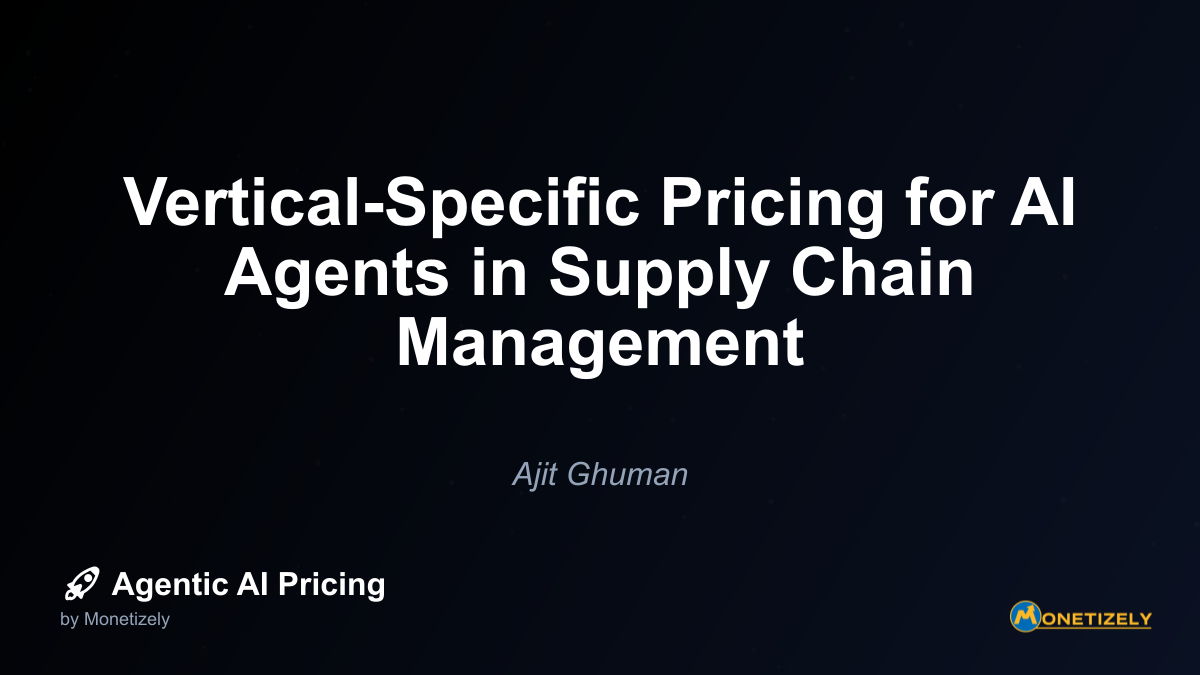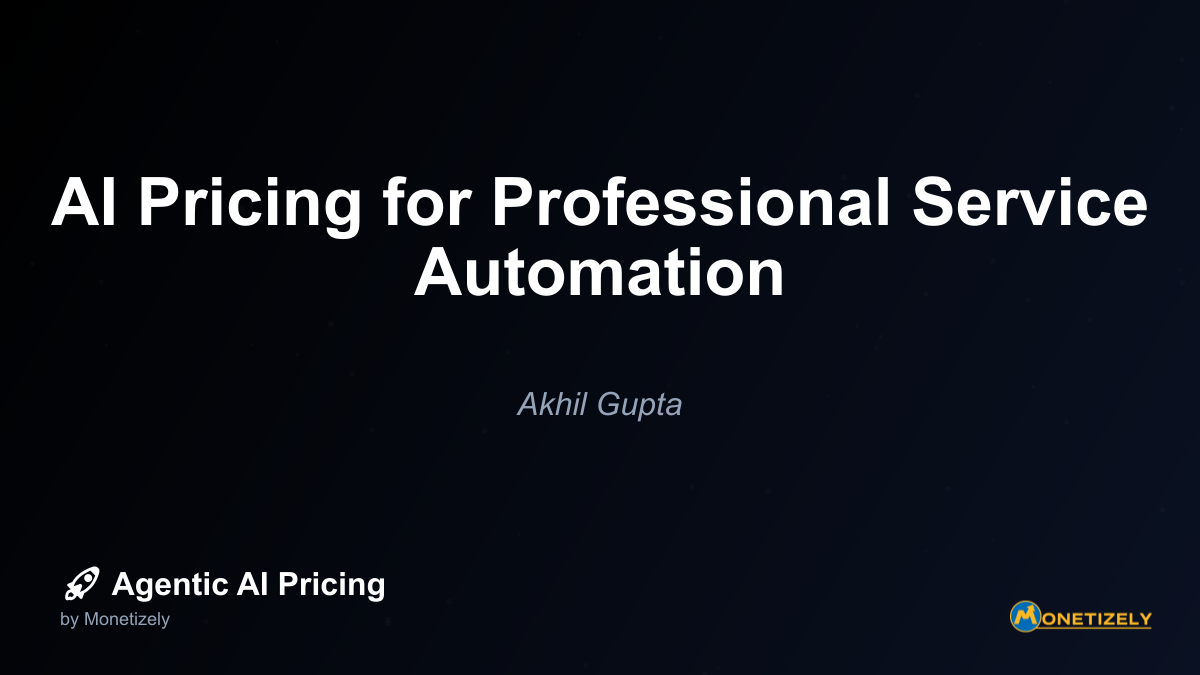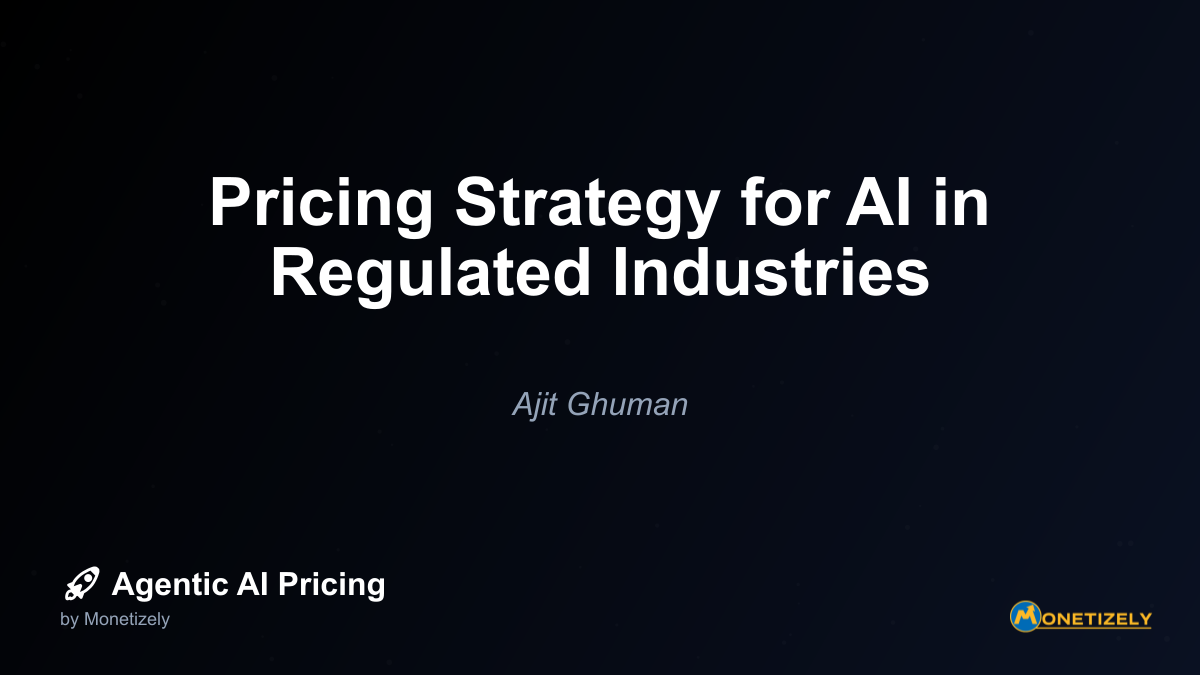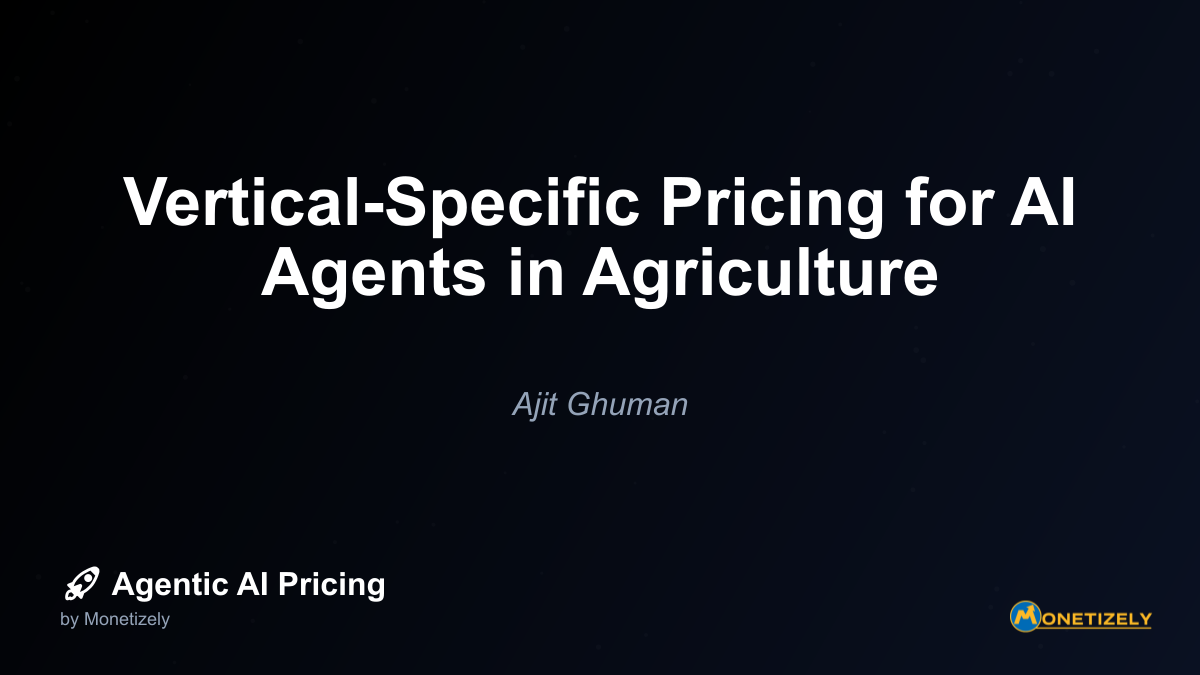· Akhil Gupta · Industry-Specific · 12 min read
Vertical-Specific Pricing for AI Agents in Manufacturing
AI and SaaS Pricing Masterclass
Learn the art of strategic pricing directly from industry experts. Our comprehensive course provides frameworks and methodologies for optimizing your pricing strategy in the evolving AI landscape. Earn a professional certification that can be imported directly to your LinkedIn profile.
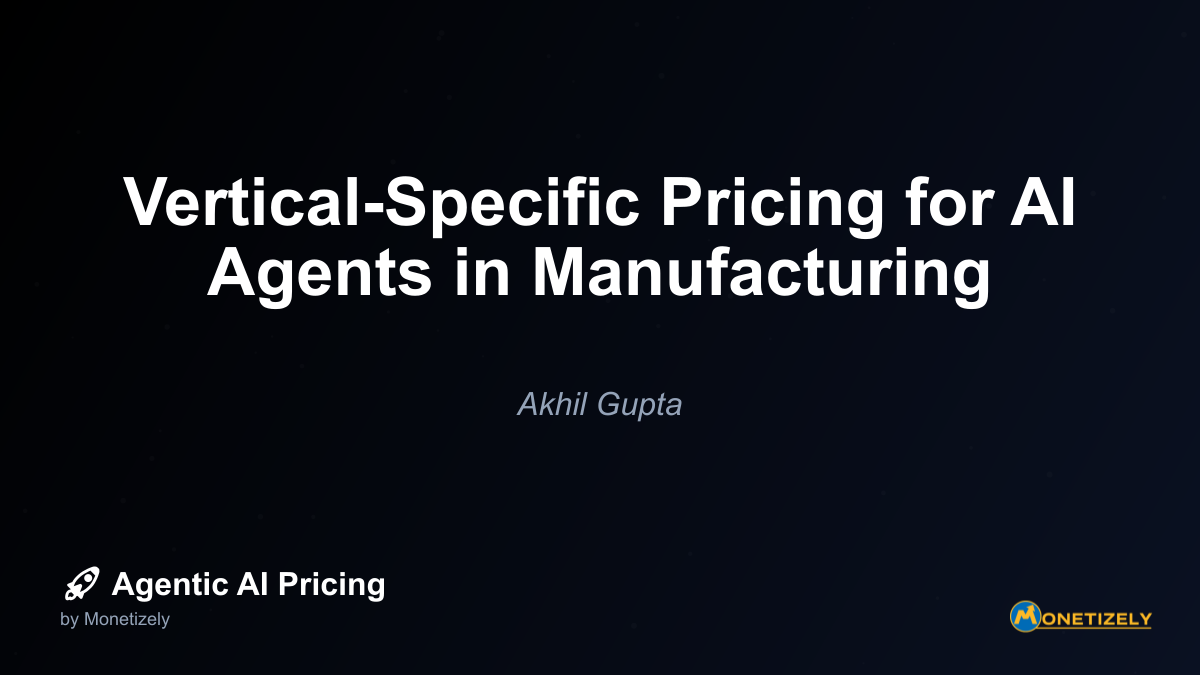
The manufacturing industry stands at a pivotal crossroads where artificial intelligence is transforming traditional production environments into intelligent, adaptive systems. While general AI pricing frameworks offer some guidance, manufacturing’s unique operational requirements, legacy infrastructure, and efficiency metrics demand specialized pricing approaches for AI agents. This deep dive explores the nuanced considerations for developing vertical-specific pricing strategies that align with manufacturing’s distinct value drivers and integration challenges.
Understanding the Manufacturing AI Value Proposition
Manufacturing represents a unique vertical for AI agent deployment due to its combination of physical assets, complex workflows, and quantifiable efficiency metrics. Unlike purely digital environments, manufacturing AI agents must bridge the gap between computational intelligence and physical production realities.
The core value proposition of AI agents in manufacturing centers on three primary dimensions:
- Operational efficiency gains - Reducing downtime, optimizing resource utilization, and streamlining production flows
- Quality improvement - Enhancing precision, reducing defects, and ensuring consistent output
- Cost reduction - Minimizing waste, optimizing energy consumption, and reducing labor costs for routine tasks
According to recent research from Boston Consulting Group, manufacturing companies implementing AI agents report efficiency improvements of 15-30% across various operational metrics, with the highest gains in predictive maintenance (28%) and quality control (24%). These tangible improvements provide a foundation for value-based pricing models that directly tie costs to measurable outcomes.
Current Market Trends in Manufacturing AI Pricing (2023-2025)
The pricing landscape for AI agents in manufacturing has evolved significantly in recent years, moving away from traditional software licensing models toward more sophisticated approaches that reflect the unique value delivery mechanisms of autonomous systems.
Evolution from Static to Dynamic Pricing Models
Traditional software pricing models in manufacturing—perpetual licenses with maintenance fees or simple SaaS subscriptions—are proving inadequate for capturing the value of AI agents. The market is rapidly shifting toward more nuanced approaches:
- Usage-based pricing reflecting cloud and LLM cost dynamics
- Agent-based pricing with fees tied to individual autonomous agents
- Outcome-based pricing directly linked to measurable business impact
These emerging models better align with the operational realities of manufacturing environments where value creation is tied to specific production outcomes rather than software utilization alone.
Industry Leaders Setting the Pace
Major industrial technology providers are pioneering new pricing approaches for their AI agent offerings:
Siemens deploys AI-powered assistants like the Industrial Copilot, which can reduce reactive maintenance time by 25%. Their pricing model increasingly ties to measurable performance improvements rather than traditional software licensing.
ABB has shifted from selling discrete hardware to offering AI-driven “uptime-as-a-service” through its ABB Ability™ platform. This approach transforms pricing into value-based contracts with recurring revenue streams tied to performance guarantees.
GE integrates machine learning within its industrial equipment division to optimize dynamic pricing based on demand forecasts and raw material cost variations, improving margin protection through predictive analytics.
These approaches demonstrate the industry’s movement toward pricing models that directly reflect value creation in manufacturing contexts.
Manufacturing-Specific Value Metrics for AI Pricing
To develop effective vertical-specific pricing for manufacturing AI agents, providers must understand and incorporate the metrics that matter most to manufacturing operations. These metrics serve as the foundation for value-based pricing models.
Key Performance Indicators in Manufacturing
Manufacturing environments measure success through specific operational metrics that directly impact financial performance:
| Metric Category | Specific KPIs | AI Agent Impact |
|---|---|---|
| Equipment Effectiveness | Overall Equipment Effectiveness (OEE), Mean Time Between Failures (MTBF), Mean Time to Repair (MTTR) | AI agents can improve OEE by 15-25% through predictive maintenance and adaptive scheduling |
| Production Performance | Throughput, Cycle Time, First Pass Yield | Autonomous optimization can reduce cycle times by 10-20% while improving quality |
| Quality Metrics | Defect Rate, Scrap Rate, Customer Returns | Vision-based AI inspection can reduce defect rates by up to 90% compared to manual inspection |
| Energy & Resource Utilization | Energy Consumption per Unit, Material Utilization Rate | AI optimization typically reduces energy consumption by 5-15% |
| Labor Productivity | Units per Labor Hour, Labor Cost per Unit | AI assistance can improve labor productivity by 20-35% |
These metrics provide a concrete foundation for value-based pricing models, allowing AI providers to tie their costs directly to the improvements they deliver.
Translating Efficiency Gains to Pricing Models
The challenge lies in converting these operational improvements into pricing structures that fairly distribute value between vendors and customers. Several approaches have emerged:
Performance-Based Pricing: Customers pay based on measurable improvements in uptime, throughput, or cost savings, creating recurring revenue and closer vendor-customer partnerships.
Dynamic Pricing Models: Driven by predictive analytics, these models adjust prices in near real-time based on market and input volatility, reflecting the actual value delivered.
Subscription or SaaS Models: For AI tools like digital twins and AI assistants, ongoing revenue is linked to continuous value delivery rather than one-time product sales.
Hybrid Models: Combining fixed base fees with variable components tied to performance metrics, providing predictability while rewarding superior outcomes.
According to a 2025 study by Bessemer Venture Partners, AI-native companies implementing these value-based pricing models reach $1 billion in annual recurring revenue 50% faster than those using traditional pricing approaches, highlighting the effectiveness of aligning pricing with manufacturing-specific value metrics.
Integration Challenges and Cost Considerations
The implementation of AI agents in manufacturing environments presents unique integration challenges that significantly impact pricing strategies. These challenges stem from the complexity of manufacturing systems, legacy infrastructure, and operational requirements.
Technical Integration Hurdles
Manufacturing environments present several distinct integration challenges:
Legacy System Integration: Manufacturing facilities often operate with equipment and control systems spanning multiple decades of technology. Integrating AI agents with outdated protocols, proprietary interfaces, and limited connectivity requires substantial custom engineering.
Data Quality and Availability: Production data may be incomplete, inconsistent, or poorly structured, creating challenges for AI accuracy. Significant preprocessing—including cleaning, normalization, and validation—is essential for reliable AI operation.
Real-time Requirements: Many manufacturing processes require millisecond-level responsiveness, placing strict performance demands on AI systems that must operate within tight time constraints.
Physical-Digital Interface: Unlike purely digital applications, manufacturing AI must interact with physical systems through sensors, actuators, and control systems, adding complexity and potential points of failure.
These integration challenges translate directly to implementation costs that must be factored into pricing strategies. According to a 2024 survey by McKinsey, integration costs typically represent 40-60% of total AI implementation expenses in manufacturing environments—significantly higher than in purely digital domains.
Cost Structure Analysis
The cost structure for AI agents in manufacturing includes several components that differ from general AI applications:
| Cost Component | Manufacturing-Specific Considerations | Impact on Pricing |
|---|---|---|
| Integration Engineering | Legacy system compatibility, custom adapters, middleware development | Higher upfront costs or extended implementation fees |
| Data Infrastructure | Sensor networks, edge computing, data preprocessing pipelines | Additional hardware and infrastructure components |
| Training & Customization | Domain-specific model training, manufacturing process knowledge | Specialized expertise requirements increasing costs |
| Operational Support | 24/7 availability requirements, production-critical support | Premium support tiers with rapid response guarantees |
| Security & Compliance | Industrial security requirements, safety regulations | Additional certification and compliance costs |
These cost elements create a fundamentally different pricing equation for manufacturing AI compared to general business applications. Successful pricing strategies must account for these higher integration and support costs while demonstrating clear ROI through operational improvements.
ROI Calculation Frameworks for Manufacturing AI
For manufacturing executives to justify investments in AI agents, clear and credible ROI calculations are essential. Effective pricing strategies must facilitate these calculations by transparently connecting costs to expected benefits.
Comprehensive ROI Calculation Approach
A manufacturing-specific ROI framework should include:
Direct Cost Savings:
- Reduced maintenance costs through predictive maintenance
- Lower energy consumption through optimized operations
- Decreased quality costs (scrap, rework, warranty claims)
- Reduced labor costs for routine tasks
Productivity Improvements:
- Increased throughput from the same equipment
- Reduced setup and changeover times
- Improved first-pass yield
- Higher asset utilization rates
Strategic Benefits:
- Increased production flexibility and responsiveness
- Enhanced product quality and consistency
- Improved workplace safety
- Knowledge capture from experienced workers
Implementation Costs:
- AI agent licensing/subscription fees
- Integration engineering
- Infrastructure upgrades
- Training and change management
The most effective ROI calculations provide a comprehensive view that includes both tangible and intangible benefits while accounting for all implementation costs.
Sample ROI Calculation for Predictive Maintenance
To illustrate this approach, consider a predictive maintenance AI agent implementation:
| Component | Calculation Approach | Example Values |
|---|---|---|
| Downtime Reduction | (Current unplanned downtime hours × hourly production value) × expected reduction percentage | 120 hours × $15,000/hr × 30% = $540,000 annually |
| Maintenance Cost Reduction | Current reactive maintenance costs × expected reduction percentage | $800,000 × 25% = $200,000 annually |
| Extended Equipment Life | (Replacement cost ÷ current life) × life extension factor | ($2M ÷ 10 years) × 15% extension = $30,000 annually |
| Implementation Costs | AI agent fees + integration costs + training | $150,000 + $300,000 + $50,000 = $500,000 first year |
| Ongoing Costs | Annual subscription + maintenance + updates | $120,000 annually |
| First-Year ROI | (Total benefits − Total costs) ÷ Total costs | ($770,000 − $500,000) ÷ $500,000 = 54% |
| Three-Year ROI | (3-year benefits − 3-year costs) ÷ 3-year costs | ($2,310,000 − $860,000) ÷ $860,000 = 169% |
This example demonstrates how manufacturing-specific metrics can be translated into financial terms that executives can use to evaluate AI investments. Effective pricing strategies should facilitate these calculations by clearly connecting costs to expected operational improvements.
Vertical-Specific Pricing Models for Manufacturing AI
Based on the unique characteristics of manufacturing environments and the value metrics discussed earlier, several pricing models have emerged as particularly effective for this vertical. Each model addresses specific aspects of manufacturing value creation and operational realities.
Model 1: Performance-Guaranteed Pricing
This model directly ties pricing to guaranteed performance improvements in specific manufacturing KPIs:
Structure:
- Base fee covering implementation and basic functionality
- Performance fees tied to improvements in agreed metrics (OEE, yield, energy efficiency)
- Risk-sharing component where vendor fees are reduced if targets aren’t met
Example Implementation: ABB’s “Uptime-as-a-Service” model guarantees specific availability levels for robotic systems. Customers pay a base fee plus variable components tied to uptime performance, with penalties if guaranteed levels aren’t achieved.
Best For:
- Critical production equipment where downtime is extremely costly
- Applications with clearly measurable performance metrics
- Scenarios where vendors have high confidence in their solution’s impact
Model 2: Production-Volume Pricing
This model scales with the volume of production affected by the AI agent:
Structure:
- Pricing tied to units produced, materials processed, or production hours
- Volume tiers with decreasing per-unit costs at higher volumes
- Minimum commitments to ensure baseline revenue
Example Implementation: A vision-based quality inspection AI charges based on the number of units inspected, with tiered pricing that decreases the per-unit cost as volume increases. This aligns the vendor’s revenue with the customer’s production volume.
Best For:
- Quality inspection and monitoring applications
- Production optimization systems
- Applications where value scales directly with production volume
Model 3: Hybrid Subscription with Outcome Bonuses
This model combines predictable subscription fees with performance incentives:
Structure:
- Core subscription based on deployment scope (number of production lines, facilities)
- Bonus payments triggered by achieving specific operational improvements
- Annual value assessments to adjust the model based on actual results
Example Implementation: Siemens Industrial Copilot offers a subscription model with additional success fees when specific maintenance time reductions or OEE improvements are achieved and validated.
Best For:
- Complex manufacturing environments with multiple improvement opportunities
- Situations requiring budget predictability with upside potential
- Ongoing optimization scenarios rather than one-time improvements
Model 4: Resource Optimization Gain-Share
This model focuses specifically on resource efficiency improvements:
Structure:
- Vendor receives a percentage of documented savings in energy, materials, or labor
- Baseline established through initial assessment period
- Regular measurement and verification process
Example Implementation: An energy optimization AI for manufacturing charges based on a percentage (typically 20-30%) of verified energy savings, with sophisticated measurement and verification protocols to document the impact.
Best For:
- Energy management systems
- Material utilization optimization
- Labor efficiency improvements
Selecting the Right Model for Different Manufacturing Contexts
The optimal pricing model varies based on manufacturing sub-vertical, process type, and organizational priorities:
| Manufacturing Context | Recommended Pricing Approach | Rationale |
|---|---|---|
| Discrete Manufacturing (Automotive, Electronics) | Production-Volume or Hybrid Subscription | Aligns with unit-based production metrics and quality focus |
| Process Manufacturing (Chemicals, Food) | Resource Optimization Gain-Share | Addresses continuous flow optimization and resource efficiency |
| Heavy Industry (Steel, Mining) | Performance-Guaranteed Pricing | Matches high-value equipment and critical uptime requirements |
| High-Mix, Low-Volume Manufacturing | Hybrid Subscription with Outcome Bonuses | Provides flexibility for variable production environments |
The key to successful vertical-specific pricing is aligning the model with the manufacturing context’s primary value drivers and operational metrics.
Human Factors in Manufacturing AI Pricing
The human dimension of AI implementation in manufacturing environments significantly impacts both value creation and adoption success. Effective pricing strategies must account for workforce transitions, skills development, and the evolving human-machine partnership.
Workforce Transformation Considerations
AI agents in manufacturing environments transform the workforce in several key ways:
- Job evolution: Workers shift from direct operators to orchestrators or curators of autonomous processes
- Skill requirements: New roles emerge focused on AI oversight, exception handling, and strategic decision-making
- Productivity enhancement: AI augments human capabilities rather than simply replacing workers
According to recent research, manufacturing AI implementations that actively address workforce transformation achieve 40% higher ROI than those focusing solely on technical deployment. This human dimension must be reflected in pricing approaches.
Pricing Implications of Human-AI Collaboration
Effective pricing models should incorporate several human factors:
Training and Change Management: Include workforce development components in pricing packages to ensure successful adoption
Value Attribution: Recognize that some benefits come from improved human decision-making rather than pure automation
Adoption Incentives: Structure pricing to reward increasing usage and capability adoption over time
Knowledge Capture: Value the preservation and amplification of institutional knowledge through AI systems
Manufacturers are increasingly seeking AI solutions that enhance rather than replace their workforce. Pricing strategies that acknowledge this human dimension gain competitive advantage through better alignment with customer priorities.
Balancing Automation with Human Expertise
The most successful manufacturing AI implementations establish a balanced collaboration between automated systems and human experts:
- AI handles 60-80% of routine decisions and processes
- Humans focus on exceptions, strategic oversight, and continuous improvement
- The combination delivers higher performance than either could achieve alone
This collaboration model should inform pricing structures, with components that recognize both automation efficiency and enhanced human capabilities. For example, a tiered pricing model might include:
- Base tier: Core automation functionality
- Advanced tier: Human-AI collaboration tools and interfaces
- Premium tier: Strategic decision support and knowledge management
By incorporating human factors into pricing models, AI providers can better align with manufacturing customers’ holistic needs and achieve higher adoption rates and customer satisfaction.
Technical Considerations that Impact Pricing
The technical architecture and implementation approach for manufacturing AI agents significantly influence both costs and value creation, directly impacting appropriate pricing strategies.
Edge Computing vs. Cloud Deployment
Manufacturing environments increasingly require edge computing capabilities to meet latency, security, and reliability requirements:
- Edge Deployment: Processing data locally on the factory floor reduces latency and ensures operation even during connectivity disruptions
- Cloud Processing: Enables more sophisticated analytics and cross-facility learning but introduces potential latency and connectivity dependencies
- Hybrid Architectures: Combine edge processing for real-time control with cloud analytics for optimization
These architectural choices have direct pricing implications:
| Deployment Model | Cost Structure Impact | Pricing Model Implications |
|---|---|---|
| Edge-Dominant | Higher upfront hardware costs, lower ongoing compute fees | Front-loaded pricing with lower subscriptions |
| Cloud-Dominant | Lower initial hardware investment, higher ongoing compute costs | Subscription-focused with usage components |
| Hybrid | Balanced initial and ongoing costs | Tiered pricing based on processing location |
Manufacturers in different industries have varying preferences. Process industries with continuous operations typically prefer edge-dominant solutions, while discrete manufacturing may accept more cloud dependency for advanced analytics capabilities.
Data Ownership and Value
Data ownership represents a critical consideration in manufacturing AI pricing:
- Who owns the production data generated during AI operation?
- Can vendors use anonymized customer data to improve their models?
- How is the value of improved models shared with data contributors?
These questions directly impact pricing
Co-Founder & COO
Akhil is an Engineering leader with over 16+ years of experience in building, managing and scaling web-scale, high throughput enterprise applications and teams. He has worked with and led technology teams at FabAlley, BuildSupply and Healthians. He is a graduate from Delhi College of Engineering and UC Berkeley certified CTO.
Pricing Strategy Audit
Let our experts analyze your current pricing strategy and identify opportunities for improvement. Our data-driven assessment will help you unlock untapped revenue potential and optimize your AI pricing approach.

